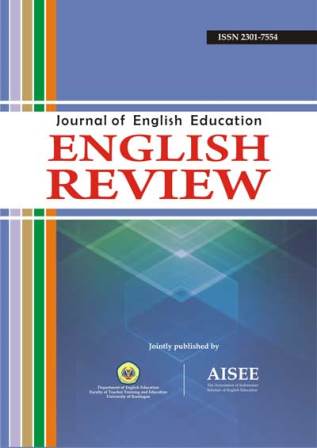Interpersonal Meaning in Netanyahu’s Speech
Abstract
This study investigates how the interpersonal meaning is realized in the speech of Israeli Prime Minister Benjamin Netanyahu. This study aimed to uncover (1) the mood structure which realized in Netanyahu‘s speech of Iran and Palestine and (2) To what extent the difference in field determine the interpersonal metafunction of the speaker. This study is largely qualitative but in order to answer those research questions, this study will be assisted by some descriptive quantification to observe the trend in the interpersonal meaning of the speaker. It applies Hallidayan theory of Systemic Functional Grammar (SFG) in analyzing the research data. The data were taken from the websites which are readily accessible to the public. Two different transcribed speeches are discovered to extract the data which are needed to investigate the interpersonal meaning. Subject, Finite and Modality are the main tools to realize the interpersonal meaning of Netanyahu in his speech. It can be realized by discovering the use of those parts in his speech in different issue and occasion. It is found that Netanyahu‘s interpersonal meaning is realized through the placement of Subject and the utilization of Finite, Modality and Mood Adjuncts. It is also found that the differences of the field influence the interpersonal meaning of the speaker through the comparison of subject and finite. The findings in this present study are expected to be useful for some purposes in the future.
Keywords: Interpersonal meaning, mood, modality.
References
Benjamin Netanyahu: full speech on Palestinian state. (2009) (2009, June 19). Retrieved from: http://www.telegraph.co.uk/news/worldnews/middleeast/israel/5535664/Benjamin-Netanyahu-full-speech-on-Palestinian-state.html.
Creswell, J. W. (2003). Qualitative inquiry & research design. Thousand Oaks: SAGE Publications.
De Beaugrande, R. (1991). Linguistic theory: The discourse of fundamental works. London: Longman.
Eggins, S. (2004). An introduction to systemic functional linguistics. New York: Continuum
Feng, H. & Liu, Y. (2010). Analysis of interpersonal meaning in public speeches—A case study of Obama’s Speech. Journal of Language Teaching and Research, 1(6), 825-829.
Gerot, L. & Wignell, P. (1994). Making sense of functional grammar. Sydney: Antipoaean Educational Enterprises.
Halliday, M.A.K & Matthiessen, M.I.M. (2004). An introduction to functional grammar (3rd edition). London: Arnold.
Halliday, M.A.K & Webster, Jonathan (2002). On Grammar. London: Continuum.
Key portions of Israeli PM Netanyahu's U.N. speech on Iran. (2012, September 27). Retrieved March 19, 2013 from: http://www.reuters.com/article/2012/09/27/us-un-assembly-israel-text-idUSBRE88Q1RR20120927. September 27, 2012.
Marczyk, G. R., DeMatteo, D & Festinger, D. (2005). Essentials of research design and methodology. New Jersey: John Wiley & Sons, Inc.
Martin, J. R. Christian Matthiessen, M. I. M. & Painter, C (1997). Working with functional grammar. London: Arnold.
Martin, J.R. (1992). English text system and structure. Philadelphia: John Benjamins Publishing Company.
Matthiessen, C. , Lam, M., & Teruya , K. (2010). Key terms in systemic functional linguistics. London: Continuum International Publishing Group.
Sugiyono (2011). Metode penelitian pendidikan, pendekatan kuantitatif, kualitatif dan R&D. Bandung: Alfabeta.
Ye, R. (2010). The interpersonal metafunction analysis of Barack Obama's victory speech. English Language Teaching. 3(2), 146-152.
All articles published in English Review: Journal of English Education (ERJEE) are licensed under the Creative Commons Attribution 4.0 International License (CC BY 4.0).
Copyright Ownership
Authors retain the copyright of their articles and grant ERJEE the right of first publication. The journal is granted a non-exclusive license to publish, reproduce, and distribute the article in any format, medium, or platform, provided that proper credit is given to the original authors.
License Terms – CC BY 4.0
Under the Creative Commons Attribution 4.0 International License, others are free to:
- Share — copy and redistribute the material in any medium or format
- Adapt — remix, transform, and build upon the material for any purpose, even commercially
As long as they:
- Provide appropriate credit to the original author(s) and source
- Provide a link to the license (https://creativecommons.org/licenses/by/4.0/)
- Indicate if any changes were made
There are no restrictions on the reuse, reproduction, or adaptation of published articles as long as attribution is properly given.
Author Warranties
By submitting a manuscript to ERJEE, authors confirm that:
- The work is original and does not infringe any existing copyright.
- The manuscript has not been previously published and is not under consideration elsewhere.
- All sources and references are appropriately acknowledged.
- Necessary permissions have been obtained for any copyrighted materials used.









